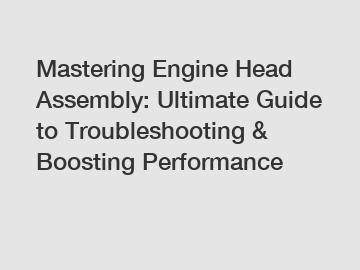Mastering Engine Head Assembly: Ultimate Guide to Troubleshooting & Boosting Performance
Mastering Engine Head Assembly: Ultimate Guide to Troubleshooting & Boosting Performance.
When it comes to the engine head assembly, troubleshooting and boosting performance are crucial factors to consider. In this ultimate guide, we will explore the steps to master engine head assembly troubleshooting and techniques for enhancing performance. By following this guide, you will be able to identify common issues, resolve them effectively, and ultimately optimize your engine's performance.
The engine head assembly plays a vital role in the overall functioning of the engine. It is responsible for sealing the combustion chamber and housing the valves, valve springs, and other critical components. Any malfunction in this assembly can lead to various problems such as poor fuel efficiency, loss of power, or even engine failure. Therefore, it is essential to address any issues promptly and effectively.

To begin troubleshooting engine head assembly, start by examining the cylinder head gasket. This gasket provides a seal between the engine block and the cylinder head, preventing any leakage of coolant or oil. Any signs of leakage, such as oil or coolant mixing, overheating, or white smoke from the exhaust, indicate a failing gasket. In such cases, replacing the gasket is necessary to ensure optimal performance and prevent further damage to the engine.
Next, it is crucial to check the valve clearance. Improper valve clearance can lead to a loss of power, reduced fuel efficiency, and even engine damage. Using a feeler gauge, measure the clearance between the valve and the rocker arm. If the clearance is not within the manufacturer's specified range, adjustment is necessary. Proper valve clearance ensures optimum valve operation and maximizes engine performance.
Another critical aspect to consider is the valve seating. Over time, the valves can develop wear, which affects their ability to seal properly. To check for valve seating issues, perform a leak-down test. This test measures the amount of pressure lost in the cylinder when the valves are closed. If there is significant pressure loss, it indicates a problem with the valve seating. To resolve this issue, valve grinding or replacement may be required.
Furthermore, examining the valve springs is essential for troubleshooting engine head assembly. Weak or broken valve springs can lead to valve float, resulting in erratic engine performance. Inspect the springs for any signs of wear, fatigue, or damage. If any issues are found, replacing the valve springs with high-quality ones is essential for maintaining proper valve operation and optimizing engine performance.
Mastering engine head assembly troubleshooting not only ensures optimal performance but also extends the engine's lifespan. Ignoring or neglecting any issues in this critical component can lead to severe consequences, such as engine failure or costly repairs. By following the steps outlined in this guide and addressing any problems promptly, you can maximize your engine's potential and enjoy a smooth and efficient driving experience.
In conclusion, mastering engine head assembly troubleshooting is essential for boosting performance and maintaining the overall health of your engine. By paying attention to the cylinder head gasket, valve clearance, valve seating, and valve springs, you can identify and resolve any issues effectively. Investing time and effort in troubleshooting and maintaining the engine head assembly will ultimately result in better performance, improved fuel efficiency, and a longer lifespan for your engine.
Want more information on 1W3860, 6150-41-4111, 188-3122? Feel free to contact us.
111
0
0


Comments
All Comments (0)